Plants belonging to the genus Pachypodium vary widely from each other in some aspects, but also share a number of basic common traits. Each species is adapted to the specific environment which it inhabits, but all species of the genus share certain anatomical and metabolic traits, reflecting their common evolutionary ancestry.
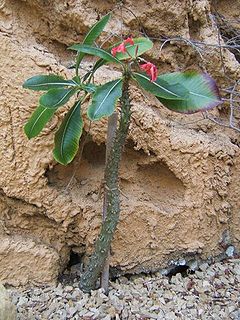
Pachypodium baronii, the Madagascar palm or bontaka, is a flowering plant in the family Apocynaceae. It has the habit of a robust shrub with a spherical or bottle-shaped trunk. It has several cylindrical branches at the top.
Pachypodium bicolor is a species of plant in the family Apocynaceae.

Pachypodium brevicaule is a species of plant that belongs to the family Apocynaceae.
Euphorbia namuskluftensis is a species of plant in the family Euphorbiaceae. It is endemic to Namibia. Its natural habitat is rocky areas. Occurs on white limestone on Namuskluft. It is a dwarf non-spiny species. It has tubers and ribosomes, that divide into numerous short branch stems. The branches have tiny sessile caduceus leaves about 2 mm long. They have tiny yellow flowers when they bloom, and are of green coloration. Grows better in mild shade, but do need a place that is bright and warm. Root rot can occur if left in wet soil for too long. Threats include pests and diseases like spider mites and mold.
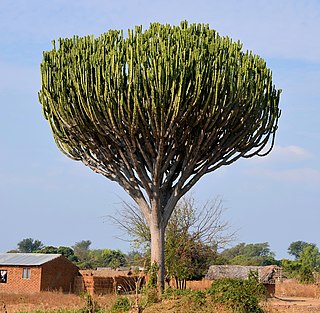
Euphorbia ingens is a species of flowering plant in the family Euphorbiaceae. It is native to dry areas of southern Africa. It is popularly known as the candelabra tree or naboom, and its milky latex can be extremely poisonous, and a dangerous irritant.

Euphorbia balsamifera is a flowering plant in the spurge family Euphorbiaceae. It is distributed in the Canary Islands and the western Sahara. It is the vegetable symbol of the island of Lanzarote. Euphorbia adenensis has been treated as a subspecies of this species.

Croton verreauxii known as the green native cascarilla is a small tree or shrub growing in dry rainforest and rainforest margins in eastern Australia.

Brunfelsia latifolia, commonly known as yesterday-today-tomorrow and kiss me quick, is a species of flowering plant in the nightshade family. Endemic to Brazil, it is an evergreen shrub that becomes semi-deciduous in cooler areas and grows up to 1.8 meters in height.

Plumbago zeylanica, commonly known as Ceylon leadwort, doctorbush or wild leadwort, is a species of plumbago with a pantropical distribution. Carl Linnaeus described the paleotropical P. zeylanica and Neotropical P. scandens as separate species, but they are currently considered synonymous.
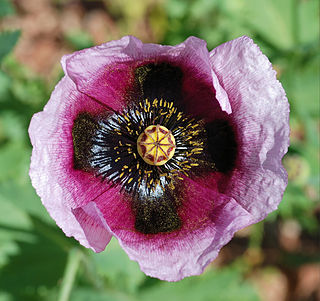
Papaver setigerum, common name poppy of Troy or dwarf breadseed poppy, is a herbaceous annual plant of the family Papaveraceae.
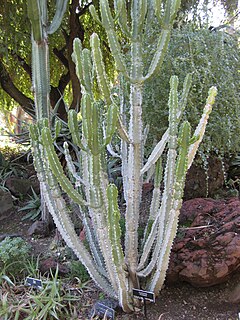
Euphorbia royleana is a species of flowering plant in the family Euphorbiaceae. It is also known as Sullu spurge, and Royle's spurge. It is a succulent and almost cactus like in appearance although unrelated. It grows right across the Himalaya mountains from Pakistan, India, Bhutan, Myanmar, Nepal to western China, It prefers dry and rocky slopes between 1000 and 1500 meters, but has been found up to 2000 meters. Flowering and fruiting is in spring to early summer (March–July) and seeding is in June–October. It is used as a hedging plant in northern India and has medicinal uses.

Hypericum revolutum is a shrub or small tree in the genus Hypericum native to Arabia and Africa. It is evergreen, with leaves opposite, closely spaced and crowded at the ends of branches, c. 20 × 5 mm, green to slightly glaucous, sessile, clasping at the base. Single bright yellow flowers form at the ends of branches, up to 5 cm in diameter, blooming from June to November. Fruit is a reddish-brown capsule, up to 13 × 10 mm.

Gleichenia polypodioides (L.) Sm., commonly known as coral fern, kystervaring or ystervaring due to its glabrous, brown, wiry stipes. The species is widespread in south- and east tropical Africa, southern Africa and the western Indian Ocean region. It occurs naturally in a broad coastal belt in South Africa, Lesotho, Swaziland, Angola, Malawi, Burundi, Tanzania, Mozambique, Zimbabwe, Mauritius, Réunion, Amsterdam Island and Madagascar, and was first described by Carl Linnaeus in 1771 under the name Onoclea polypodioides. Often forming dense and impenetrable thickets, sometimes over large areas, this rhizomatous perennial is an important pioneer in disturbed areas such as pine plantations. It is often mistakenly seen as an exotic invader rather than as a useful rehabilitation plant, a source of peat and growing medium, while showing exceptional resistance to herbicides.
Rhizome brown, 1–2.5 mm. in diam., creeping, with long-spined dark-brown scales up to 0.5 mm. in diam., with fronds spaced 2–20 cm. apart. Stipe castaneous, up to 60 cm. long and up to 1.5 mm. in diam., glabrous or with a few scales similar to those on the rhizome, shallowly sulcate. Frond bifurcate to reniform-lunate in outline, with 1 level of false dichotomy in each lateral branch system arising from each side of the terminal bud; all branches bearing distant foliar segments. Aborted apical buds up to 1.2 mm. long, clothed in dark-brown lanceolate laciniate scales. Pinnules linear, up to 7 x 0.75 cm., pinnate, usually glabrous, divided into sessile rounded entire triangular lobes, 3 x 2 mm., green to glaucous below. Sori partially immersed in the lamina, consisting of 2–4 sporangia, each in a separate but adjoining pit.

Gymnosporia nemorosa is a spiny, somewhat sprawling evergreen shrub or small tree with drooping branches growing to some 5 m tall and found along forest edges in Mpumalanga, Eswatini, KwaZulu-Natal south to the Garden Route in the Southern Cape. In Maputaland the species adopts the form of a geoxylic suffrutex or ‘underground’ tree, with shoots sprouting from its woody, underground axis.

Encephalartos concinnus is a species of cycad in the family Zamiaceae. It is endemic to Zimbabwe. It is known as the Runde cycad.
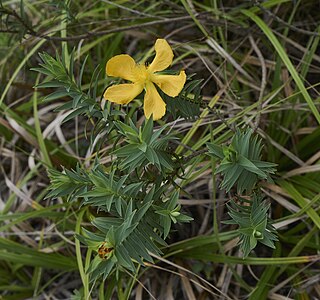
Hypericum terrae-firmae is a woody perennial flowering plant in the St. John's wort family Hypericaceae. It is an endemic plant species of Belize.

Gymnosporia buxifolia is a species of plant in the family Celastraceae native to southern Africa. It is commonly known as the pioneer spike-thorn or common spike-thorn.

Hypericum coris, the heath-leaved St. John's wort, also called yellow coris, is a species of flowering plant in the family Hypericaceae, and is the type species of sect. Coridium. It is a low shrub, and it is found in Switzerland and northwestern Italy. The species has been a popular garden plant since the 18th century, valued for its long flowering period and for how well it adapts to cultivation.

Protea pendula, also known as the nodding sugarbush or arid sugarbush, is a flowering plant of the genus Protea, in the family Proteaceae, which is only found growing in the wild in the Cape Region of South Africa. In the Afrikaans language it is known as knikkopsuikerbossie or ondersteboknopprotea.


















